What’S the Best Way to Explore Tokyo’S Historical Temples and Shrines?
To best explore Tokyo's historical temples and shrines, you should start your days early, taking advantage of the peaceful morning hours. Plan your route using a map and Tokyo's efficient public transit to maximize your time. Consider hitting well-known spots like Senso-ji and Meiji Shrine at sunrise for a truly serene experience. Dress modestly, follow the local etiquette, and if you can, grab a transit pass to simplify your travel between sites. Opt for guided tours if you prefer structured insights, or go solo for a more personal journey. Further exploration will reveal more about these cultural gems.
Planning Your Temple Tour
To make the most of your visit to Tokyo's historic temples and shrines, you'll need a well-organized plan. Start by researching the most significant sites. Senso-ji, Meiji Shrine, and Yasukuni Shrine are must-visits, each offering unique insights into Japan's rich culture and history. You should prioritize which temples and shrines resonate most with your interests, whether it's architectural grandeur, spiritual significance, or historical relevance.
Next, consider the logistics. Tokyo's temples are spread across the city, so plot them on a map to determine an efficient route. This'll save you time and help you cover more ground.
Don't forget to factor in transportation options. The city's reliable public transit system can get you close to most sites, but you might need to walk or take a taxi for the last stretch.
Early Morning Visits
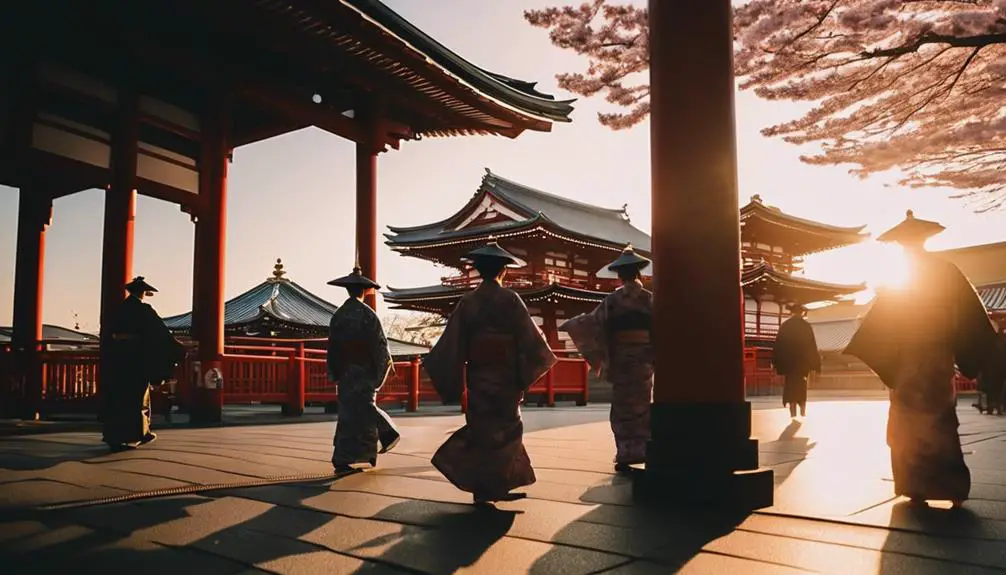
Starting your temple visits early in the morning lets you experience these serene sites before the crowds arrive. Imagine wandering through the tranquil gardens of Nezu Shrine with only the sound of chirping birds or stepping onto the smooth stones of Senso-ji as the first rays of sun light up its majestic structure. The early morning light not only offers a peaceful atmosphere but also provides perfect lighting for those breathtaking photos you'll want to share.
Walking through these historical locations in the quiet of dawn, you'll feel a deeper connection to the rich history and spirituality that permeates the air. This is your chance to reflect and absorb the ambiance without the distraction of heavy tourist traffic.
Here's a quick guide to help you plan:
| Temple/Shrine | Opening Hours | Special Notes |
|---|---|---|
| Senso-ji | 06:00 AM | Perfect for photographers seeking soft morning light |
| Meiji Shrine | Sunrise | Offers a more spiritual experience with morning rituals |
| Yasukuni Shrine | 06:00 AM | Less crowded, ideal for a reflective visit |
Utilizing Public Transportation

As you plan your temple visits in Tokyo, understanding the city's transit system is key.
You'll find that investing in a transit pass can save you both time and money.
Let's explore how you can navigate through Tokyo efficiently using these options.
Navigating Tokyo's Transit
Traversing Tokyo's extensive public transportation system is essential for efficiently exploring the city's historical temples and shrines. You'll find that maneuvering this network, though intimidating at first, becomes simpler with a bit of practice and some helpful tips.
Firstly, familiarize yourself with the major lines that are most useful for temple visits. The JR Yamanote Line, for instance, circles central Tokyo and provides access to several key areas. Meanwhile, the Tokyo Metro offers extensive coverage that can get you close to many hidden gems.
When planning your route, apps like Google Maps are invaluable. They provide real-time updates, station information, and walking directions from the nearest stops to your destination. Always check the last train times; Tokyo's public transport isn't 24-hour, and missing the last connection can mean an expensive taxi ride.
Remember, stations can be large and have multiple exits, so note the exit number recommended by your navigation app to save time.
Also, during rush hour, trains can be incredibly crowded. Try to schedule your temple visits during off-peak hours to avoid the crush and make your journey more pleasant.
Transit Pass Benefits
Exploring Tokyo's historical temples and shrines becomes more cost-effective and convenient with a transit pass. You'll find that hopping from one site to another is a breeze when you're not fumbling for change or trying to decipher ticket prices at each train station.
A transit pass, such as the Tokyo Metro Pass, allows you unlimited rides on numerous lines. This means you can visit sites like Senso-ji, Meiji Shrine, and Yasukuni Shrine without the hassle of buying individual tickets.
You also don't have to worry about peak travel costs. With a flat rate for the day or multiple days, you can travel anytime without extra charges, making it easier to change plans on the go. This flexibility is essential, especially if you're trying to fit multiple attractions into one day.
Moreover, using a transit pass can offer additional discounts at select shops and attractions. Some passes include coupons or guidebooks that point you to other hidden gems or provide discounts on souvenirs and dining.
This way, you're not just saving on transportation but enhancing your overall travel experience in Tokyo.
Guided Tours Vs Solo Exploration
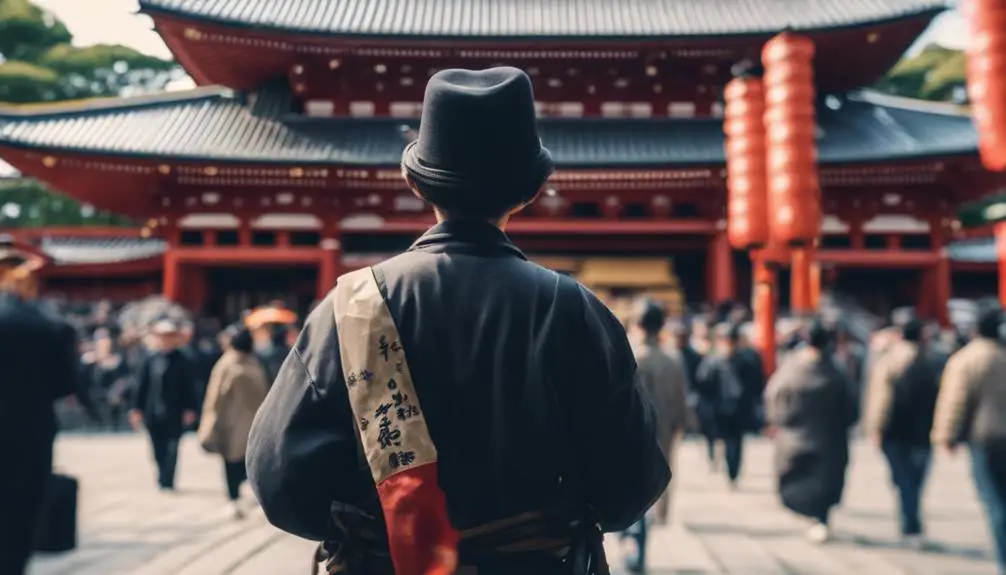
You can either join a guided tour or explore Tokyo's historic temples and shrines on your own. Each option offers unique advantages and can shape your experience differently.
Opting for a guided tour, you'll benefit from the knowledge of local experts who are familiar with the history and significance of each site. Guides often share fascinating stories and insights that you might miss on your own. They can also help navigate the vast city, making your journey more efficient, especially if you're tight on time.
Additionally, guided tours often include transportation and entry fees, making them a convenient, all-in-one package.
On the other hand, exploring solo allows you to move at your own pace and choose the sites that interest you the most. You'll have the flexibility to linger longer at places that catch your fancy or skip crowded spots that don't appeal as much.
This option can be more relaxing and personal, giving you a chance to connect more deeply with the surroundings. However, you'll need to plan your route and manage logistics yourself, which can be a thrilling or challenging task, depending on your travel style.
Cultural Etiquette Essentials
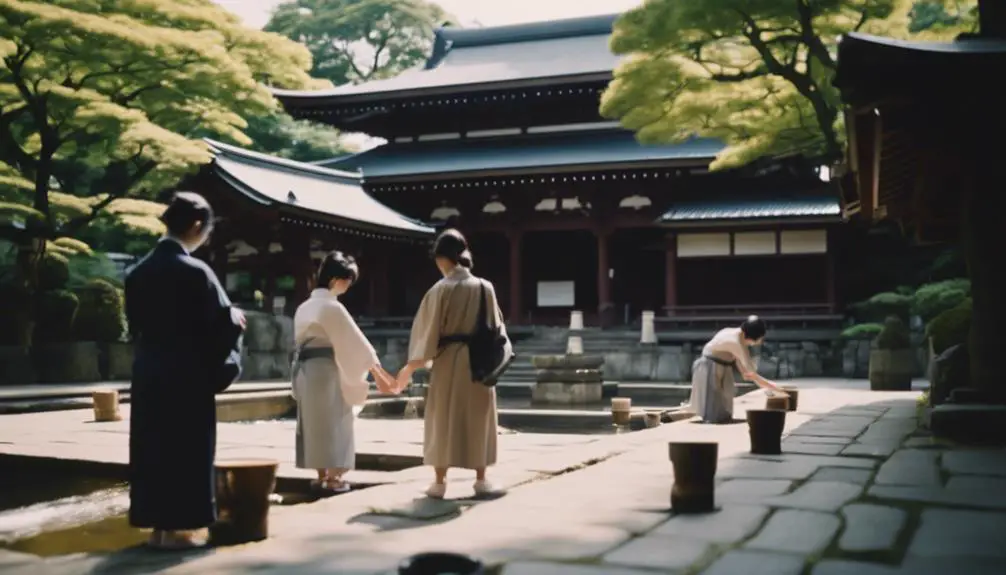
When visiting Tokyo's temples and shrines, it's important to understand and respect the local cultural etiquette. Japan holds a deep reverence for traditions and rituals, and as a visitor, you'll want to make sure that your behavior reflects respect and mindfulness. Here's a concise guide to help you navigate these sacred spaces respectfully:
- Dress Appropriately: Always opt for modest attire when entering temples and shrines. This means covering your shoulders and knees. Avoid loud or flashy outfits that might draw unnecessary attention or show disrespect to the spiritual environment.
- Observe Silence: These places aren't just tourist attractions; they're active sites of worship and meditation. Keep your voice down, silence your phone, and move quietly. This respect for silence allows everyone, including yourself, to better appreciate the serene and sacred atmosphere.
- Follow Rituals Correctly: At the entrance of a shrine, you'll often find a chozuya or temizuya (water ablution basin) for purification. Use the ladle provided to wash both hands, then rinse your mouth (don't drink directly from the ladle), and finally, rinse the ladle itself. This practice isn't just about physical cleanliness but also spiritual purification before approaching the gods.
Adhering to these guidelines makes sure that you honor the cultural significance of these historical sites and contribute to the preservation of their sanctity.
Seasonal Considerations
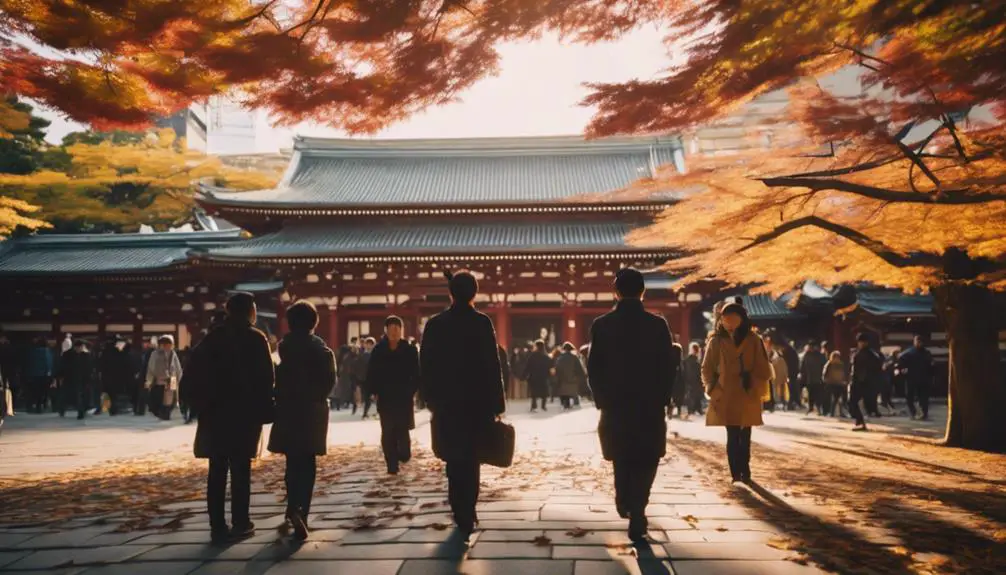
As you plan your visits to Tokyo's temples and shrines, it's essential to take into account the seasonal dynamics that can shape your experience.
Be mindful of peak visiting times, as crowds can greatly affect your ability to enjoy the serene atmosphere.
Additionally, weather variations and special festive periods throughout the year offer unique experiences but also present challenges, such as heavier foot traffic and varying temple accessibility.
Peak Visiting Times
Many visitors find spring and autumn ideal for exploring Tokyo's temples and shrines, due to the mild weather and scenic beauty. However, these seasons also bring peak crowds. Here's what you should consider when planning your visit:
1. Golden Week and Cherry Blossom Season:
In late March to early April, cherry blossoms bloom, drawing massive crowds, especially at famous spots like Ueno Park and Asakusa. Similarly, Golden Week (late April to early May) sees a surge in domestic tourism, as it's a national holiday period in Japan.
2. Autumn Festivals:
October and November not only showcase beautiful fall colors but also coincide with several cultural festivals. Events like the Kanda Matsuri at Kanda Shrine or the Hachiman-gu Shrine's Autumn Festival attract both locals and tourists, making these temples particularly busy.
3. New Year Celebrations:
The first few days of January are exceptionally crowded, as many people participate in Hatsumode, the first shrine visit of the New Year. Famous shrines like Meiji Shrine can have visitors numbering in the hundreds of thousands.
To avoid the thickest crowds, consider visiting on weekdays or during less popular times of the year. You'll find a more tranquil atmosphere that'll let you appreciate the spiritual and architectural beauty without the rush.
Weather Impact
Understanding how Tokyo's weather varies with the seasons will help you decide the best time to visit its historical temples and shrines.
Spring and autumn are generally considered the most comfortable times for your explorations. In spring, typically from late March to early May, you'll experience mild temperatures and the breathtaking cherry blossoms, providing a stunning backdrop for temple visits. However, it's also a peak tourist season, so you'll need to navigate through larger crowds.
Autumn, from September to November, offers vibrant fall colors that spectacularly frame the ancient architecture. The weather is cooler and less humid, making it ideal for walking around the extensive temple grounds.
Summer, on the other hand, can be challenging. From June to August, Tokyo becomes hot and humid, often exceeding 30°C. This can make any outdoor activity quite strenuous, and you might find yourself seeking refuge more often than enjoying the sights.
Winter, from December to February, sees colder temperatures, sometimes dropping below 5°C. While it's less crowded, you'll need to bundle up, as many older temples aren't fully heated.
Each season offers a unique perspective of Tokyo's temples and shrines, but spring and fall provide the most comfortable and visually appealing experiences.
Festive Periods
Exploring Tokyo's temples and shrines during festive periods offers you a vibrant glimpse into traditional celebrations and customs. The city bursts into life as locals and tourists alike gather to honor ancient rites and partake in joyful festivities.
To truly immerse yourself in these cultural experiences, here are some key festivals to take into account:
- New Year (Shogatsu): This is perhaps the most significant time to visit, as families cleanse away the past year and welcome the new one. Meiji Shrine and Asakusa Shrine are particularly bustling, with food stalls, decorations, and throngs of visitors making their first prayers of the year.
- Cherry Blossom Festival (Hanami): Late March and early April are mesmerizing as cherry blossoms (sakura) bloom across Tokyo. Ueno Park, with its numerous temples and shrines, offers spectacular views and traditional performances. It's a perfect time for you to experience 'hanami', the cherry blossom viewing parties.
- Tanabata Festival: Held in July, this star festival is marked by vibrant decorations and colorful streamers. Visit Asagaya Shrine to see how Tokyoites write their wishes on tanzaku papers and hang them on bamboo branches, hoping for their fulfillment.
Each festival brings unique rituals and atmospheres, making any visit a memorable plunge into Japan's rich cultural tapestry.
Hidden Gems and Lesser-Known Sites
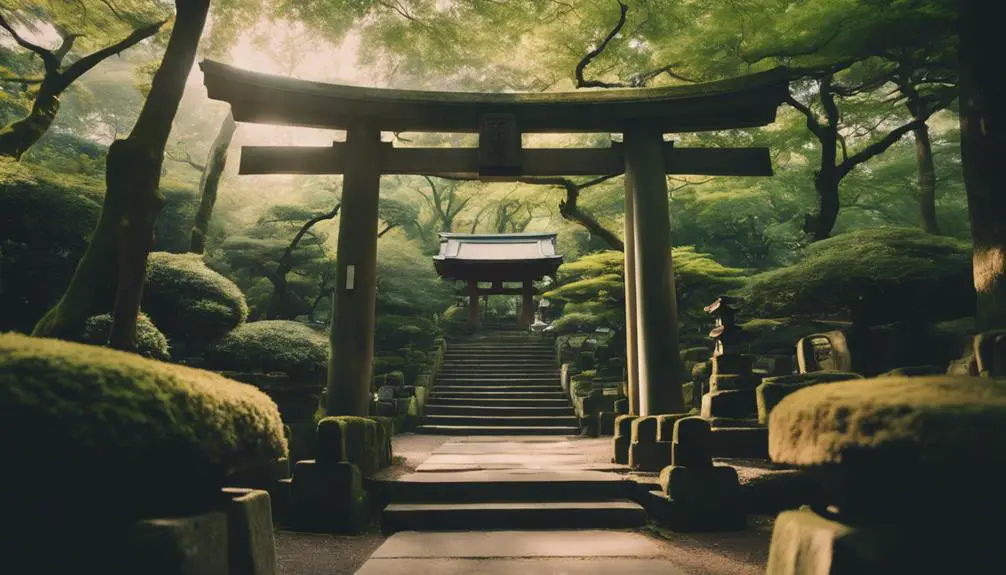
Tokyo's lesser-known temples and shrines offer a quiet escape from the bustling city life. You'll find that places like Todoroki Valley's temple, hidden away in a serene setting, provide a perfect spot for reflection away from crowded tourist hotspots. There's a unique charm in exploring these less frequented sites where you can truly appreciate the tranquility and spiritual significance without the rush.
Venture out to the Yanaka area, where the atmosphere shifts dramatically from the high-paced city scenes. Here, the old town vibe complements the ancient temples scattered around, each with stories whispering through their aged walls. You won't just see; you'll feel the history resonate.
Don't miss Kuhombutsu Joshinji, located in a quiet residential area. This temple, known for its beautiful garden and impressive statues, lets you investigate a peaceful contemplation. You'll often find yourself alone with your thoughts, accompanied only by the soft sounds of nature and occasional local devotees.
Exploring these spots, you'll uncover the layers of Tokyo's history and spirituality at your own pace, making each visit a personal discovery. So, take your time, wander off the beaten path, and let these hidden gems surprise you.
Combining Temples With Nature
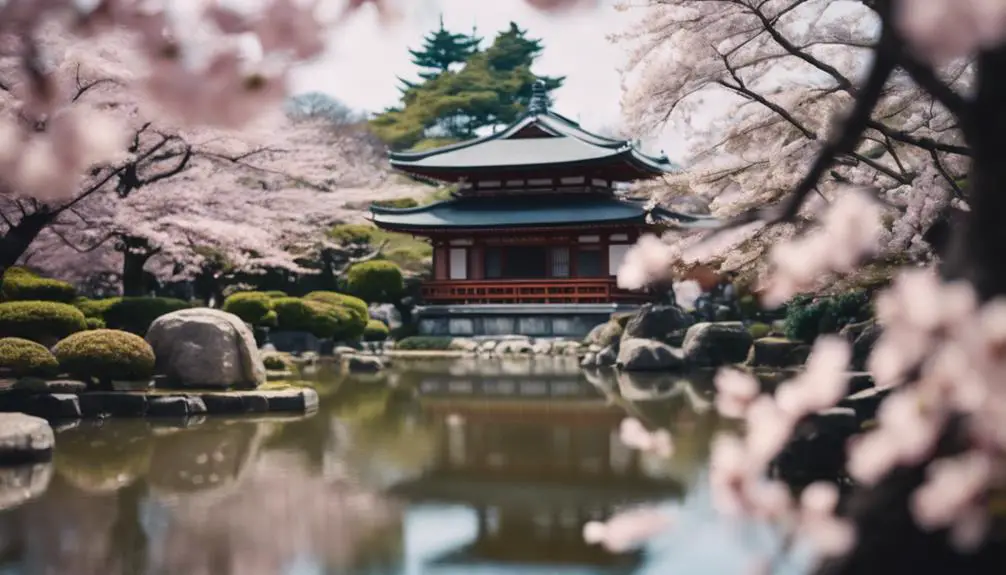
As you continue your journey, consider how Tokyo's temples blend seamlessly with natural landscapes, enhancing the spiritual experience. These sacred sites offer not just a glimpse into the city's spiritual and cultural history, but also an opportunity to connect with nature. Whether it's a serene garden, a bustling forest path, or the tranquil sound of water, nature is an integral part of the temple environment in Tokyo.
To truly appreciate this blend, here are a few ways you can immerse yourself in the natural beauty surrounding Tokyo's temples:
- Visit Meiji Jingu: Nestled within a lush forest, this Shinto shrine offers paths lined with towering trees and traditional torii gates. The surrounding Yoyogi Park changes with the seasons, providing a colorful backdrop during autumn and a vibrant green in spring.
- Explore Nezu Shrine: Famous for its azalea festival in late spring, Nezu Shrine features a traditional Japanese garden with ponds, a small waterfall, and well-manicured bushes, perfect for a peaceful walk.
- Stroll through the gardens of Asakusa Shrine: Located next to the bustling Sensoji Temple, Asakusa Shrine offers a contrast with its quiet, landscaped garden. It's a spot where you can pause and enjoy the calm amidst the city's hustle.
Embrace these natural settings as they deepen your understanding and appreciation of Tokyo's temples and shrines.
Photography Tips and Restrictions
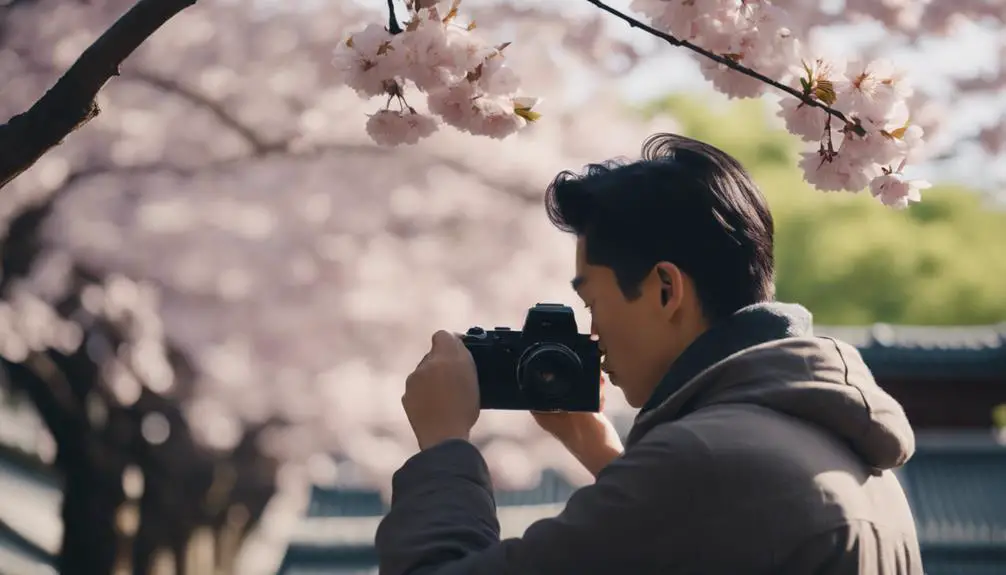
When visiting these historical sites, it's crucial to understand the photography rules to respect both cultural norms and restrictions. Many temples and shrines in Tokyo have specific guidelines that you must follow. Often, you'll find signs indicating whether photos are allowed. If you're unsure, it's always best to ask a staff member or look for posted rules near the entrance.
You should be aware that inside the main hall of many temples, photography is typically prohibited. This rule helps preserve the sacred atmosphere and guarantees that worshippers can pray without disturbances. In contrast, taking photos of the outer temple grounds is usually acceptable, but using flash is often frowned upon as it can be disruptive.
Always be discreet with your camera. Avoiding loud noises like the beep of a camera or the click of a shutter helps maintain the serene environment. Remember, the goal is to capture the beauty and spirit of the place without interrupting the tranquility.
Lastly, when you're capturing these stunning locations, don't forget to enjoy the moment too. It's easy to get caught up in getting the perfect shot and miss out on the actual experience.
Reflecting on Your Spiritual Journey
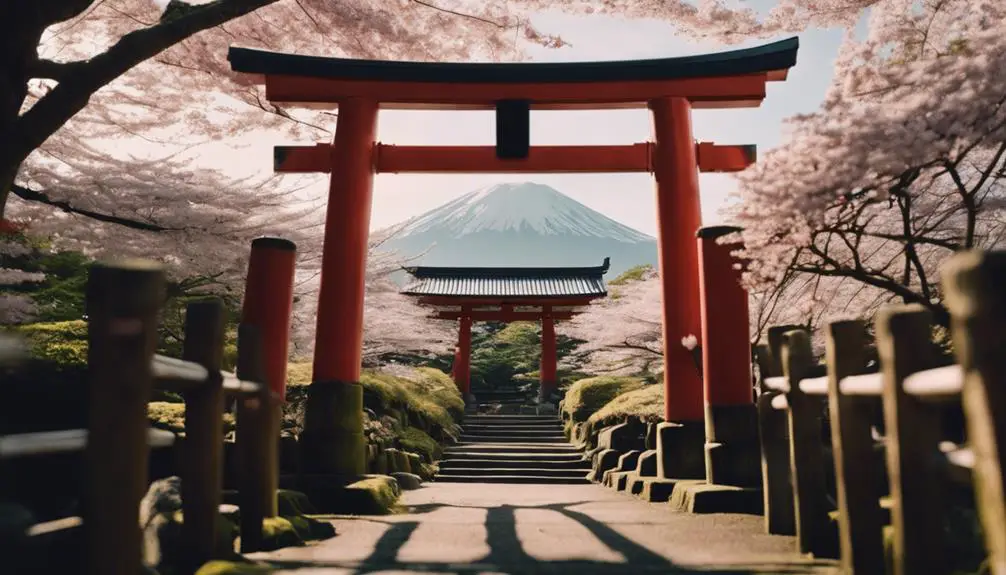
As you wander through Tokyo's serene temples and shrines, you'll find a unique opportunity to explore personal spiritual insights.
Take a moment to embrace the quiet reflection these sacred spaces offer, allowing you to connect with deeper aspects of yourself.
Consider how the cultural beliefs surrounding you impact your own spiritual views and journey.
Personal Spiritual Insights
You might discover profound spiritual insights as you wander through Tokyo's ancient temples and shrines, each step echoing centuries of devotion.
As you immerse yourself in these sacred spaces, you'll likely feel a connection to something greater than yourself. It's more than just observing; it's about experiencing a deep resonance with the past and present spiritual practices.
Here are three ways you might gain spiritual insights:
- Understanding Symbolism: Each temple and shrine is rich with symbolic elements. From the architecture to the rituals, understanding these symbols can offer insights into the broader spiritual and cultural context of Japan.
- Observing Rituals: Participating in or watching the rituals performed at these sites can be enlightening. The meticulous care and reverence in these practices can help you appreciate the depth of devotion and dedication that shapes spiritual life in Japan.
- Connecting with Nature: Many temples and shrines are located in areas that highlight the natural beauty of Japan. The serene settings can help you reflect on the interconnectedness of nature and spirituality, deepening your own spiritual perspective.
Exploring these aspects can enrich your visit, making each moment not just a tour, but a pivotal part of your spiritual journey.
Embracing Quiet Reflection
Take a moment to sit quietly in these sacred spaces, reflecting on your own spiritual journey and the insights you've gained. As you sit beneath the ornate carvings and serene statues, you can't help but feel a deep sense of peace wash over you. This tranquility is a gift, inviting you to look inward and perhaps question, or even reaffirm, your own beliefs and values.
Feel the smooth wood of the temple bench and listen to the soft rustle of leaves outside, the distant clatter of the city fading away. It's in these moments of solitude and silence that you might find clarity. Each temple and shrine, with its unique history and spiritual significance, offers a new perspective, a new piece of the puzzle that's your own evolving spiritual narrative.
Allow yourself this pause, this break from the hustle of everyday life. You're not just visiting; you're connecting with something greater, something timeless. Reflect on what brought you here, what you hope to carry forward, and how this journey might shape the chapters to come in your life's story. This isn't just tourism—it's a pilgrimage of the soul.
Cultural Beliefs Impact
How do the cultural beliefs embodied by Tokyo's temples and shrines influence your spiritual reflections? Walking through the serene pathways, surrounded by towering gates and ancient structures, you'll find yourself enveloped in a tapestry of religious and cultural significance that shapes how you perceive and connect with spirituality.
Here's how your journey through these sacred sites can deepen your spiritual reflections:
- Connection with History: Each temple and shrine in Tokyo is steeped in centuries of history. You're not just visiting a place of worship; you're stepping into a story that has been unfolding for generations. This connection to the past may prompt you to reflect on the enduring nature of spiritual beliefs and how they've supported communities through time.
- Understanding Different Beliefs: Tokyo's temples and shrines are primarily Shinto or Buddhist. Engaging with these practices can broaden your perspective, helping you appreciate the diversity of spiritual paths and the common threads of love, compassion, and community they share.
- Personal Reflection and Peace: The tranquil environment of these spiritual sites offers a perfect backdrop for introspection. The rituals and symbols, from purification fountains to incense burning, can guide your thoughts inward, fostering a moment of peace amidst the hustle of everyday life.
